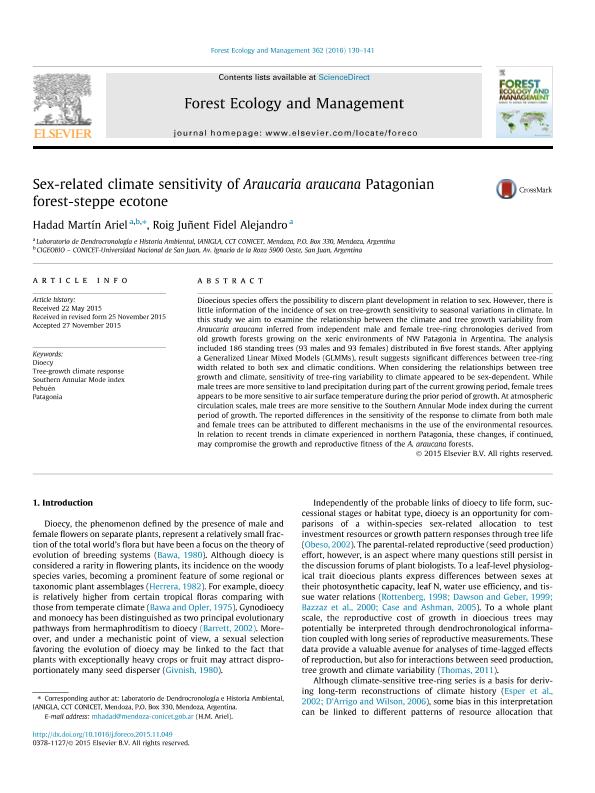Mostrar el registro sencillo del ítem
dc.contributor.author
Hadad, Martín Ariel

dc.contributor.author
Roig Junent, Fidel Alejandro

dc.date.available
2018-09-28T19:21:19Z
dc.date.issued
2016-02
dc.identifier.citation
Hadad, Martín Ariel; Roig Junent, Fidel Alejandro; Sex-related climate sensitivity of Araucaria araucana Patagonian forest-steppe ecotone; Elsevier Science; Forest Ecology and Management; 362; 2-2016; 130-141
dc.identifier.issn
0378-1127
dc.identifier.uri
http://hdl.handle.net/11336/61288
dc.description.abstract
Dioecious species offers the possibility to discern plant development in relation to sex. However, there is little information of the incidence of sex on tree-growth sensitivity to seasonal variations in climate. In this study we aim to examine the relationship between the climate and tree growth variability from Araucaria araucana inferred from independent male and female tree-ring chronologies derived from old growth forests growing on the xeric environments of NW Patagonia in Argentina. The analysis included 186 standing trees (93 males and 93 females) distributed in five forest stands. After applying a Generalized Linear Mixed Models (GLMMs), result suggests significant differences between tree-ring width related to both sex and climatic conditions. When considering the relationships between tree growth and climate, sensitivity of tree-ring variability to climate appeared to be sex-dependent. While male trees are more sensitive to land precipitation during part of the current growing period, female trees appears to be more sensitive to air surface temperature during the prior period of growth. At atmospheric circulation scales, male trees are more sensitive to the Southern Annular Mode index during the current period of growth. The reported differences in the sensitivity of the response to climate from both male and female trees can be attributed to different mechanisms in the use of the environmental resources. In relation to recent trends in climate experienced in northern Patagonia, these changes, if continued, may compromise the growth and reproductive fitness of the A. araucana forests.
dc.format
application/pdf
dc.language.iso
eng
dc.publisher
Elsevier Science

dc.rights
info:eu-repo/semantics/openAccess
dc.rights.uri
https://creativecommons.org/licenses/by-nc-nd/2.5/ar/
dc.subject
Dioecy
dc.subject
Patagonia
dc.subject
PehuÉN
dc.subject
Southern Annular Mode Index
dc.subject
Tree-Growth Climate Response
dc.subject.classification
Otras Ciencias de la Tierra y relacionadas con el Medio Ambiente

dc.subject.classification
Ciencias de la Tierra y relacionadas con el Medio Ambiente

dc.subject.classification
CIENCIAS NATURALES Y EXACTAS

dc.title
Sex-related climate sensitivity of Araucaria araucana Patagonian forest-steppe ecotone
dc.type
info:eu-repo/semantics/article
dc.type
info:ar-repo/semantics/artículo
dc.type
info:eu-repo/semantics/publishedVersion
dc.date.updated
2018-09-27T20:24:17Z
dc.journal.volume
362
dc.journal.pagination
130-141
dc.journal.pais
Países Bajos

dc.journal.ciudad
Amsterdam
dc.description.fil
Fil: Hadad, Martín Ariel. Consejo Nacional de Investigaciones Científicas y Técnicas. Centro Científico Tecnológico Conicet - Mendoza. Instituto Argentino de Nivología, Glaciología y Ciencias Ambientales. Provincia de Mendoza. Instituto Argentino de Nivología, Glaciología y Ciencias Ambientales. Universidad Nacional de Cuyo. Instituto Argentino de Nivología, Glaciología y Ciencias Ambientales; Argentina
dc.description.fil
Fil: Roig Junent, Fidel Alejandro. Consejo Nacional de Investigaciones Científicas y Técnicas. Centro Científico Tecnológico Conicet - Mendoza. Instituto Argentino de Nivología, Glaciología y Ciencias Ambientales. Provincia de Mendoza. Instituto Argentino de Nivología, Glaciología y Ciencias Ambientales. Universidad Nacional de Cuyo. Instituto Argentino de Nivología, Glaciología y Ciencias Ambientales; Argentina
dc.journal.title
Forest Ecology and Management

dc.relation.alternativeid
info:eu-repo/semantics/altIdentifier/doi/http://dx.doi.org/10.1016/j.foreco.2015.11.049
dc.relation.alternativeid
info:eu-repo/semantics/altIdentifier/url/https://www.sciencedirect.com/science/article/pii/S037811271500688X
Archivos asociados
